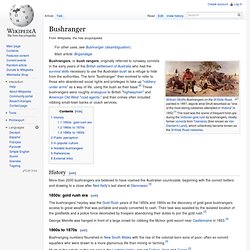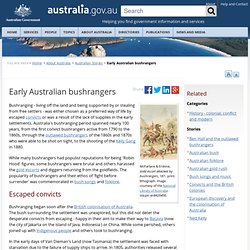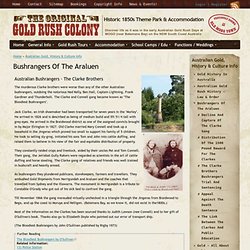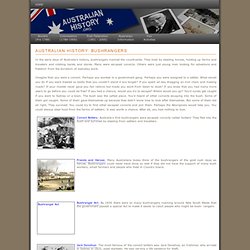

Australian Bushrangers. Bushrangers of Australia. Bushranger. History[edit] More than 2000 bushrangers are believed to have roamed the Australian countryside, beginning with the convict bolters and drawing to a close after Ned Kelly's last stand at Glenrowan.[3] 1850s: gold rush era[edit] The bushrangers' heyday was the Gold Rush years of the 1850s and 1860s as the discovery of gold gave bushrangers access to great wealth that was portable and easily converted to cash.

Their task was assisted by the isolated location of the goldfields and a police force decimated by troopers abandoning their duties to join the gold rush.[3] George Melville was hanged in front of a large crowd for robbing the McIvor gold escort near Castlemaine in 1853.[3] 1860s to 1870s[edit] Bushranging numbers flourished in New South Wales with the rise of the colonial-born sons of poor, often ex-convict squatters who were drawn to a more glamorous life than mining or farming.[3]
Bushrangers. The Australian Bushrangers. The Australian Bushrangers Who, What, When, Where Why?

The term “Bushranger” has definitely changed over the years. In the very early years, it simply referred to good bush men who possessed the horsemanship, hunting, and survival skills needed for living in the Australian bush, or wild, after they fled Australia’s prison colonies. Now, the term is used to refer to criminals who attacked travelers on the road in the bush. It’s impossible to say just how many bushrangers walked Australia’s bush, although there had to be hundreds.
Australia was originally colonized largely by English criminals. Gold Rush The second major contributing factor to bushranging was the Victorian Gold rush that occurred in the 1850s and 1860s. Dress Bushrangers typically dressed in very cheap, rough clothes. Famous Bushrangers Other resources: Activities: Different Australian history and activities, including bushwalker activities.
Related Categories. BUSHRANGERS. Australian Bushrangers. Early Australian bushrangers. McFarlane & Erskine, Gold escort attacked by bushrangers, 187-, print: lithograph.

Image courtesy of the : nla.pic-an8420450. Bushranging - living off the land and being supported by or stealing from free settlers - was either chosen as a preferred way of life by escaped or was a result of the lack of supplies in the early settlements. Australia's bushranging period spanned nearly 100 years, from the first convict bushrangers active from 1790 to the 1860s, through the of the 1860s and 1870s who were able to be shot on sight, to the shooting of the in 1880. While many bushrangers had populist reputations for being 'Robin Hood' figures; some bushrangers were brutal and others harassed the and diggers returning from the goldfields. The popularity of bushrangers and their ethos of 'fight before surrender' was commemorated in and . Escaped convicts Bushranging began soon after the . The first bushrangers, 1790s - 1820s Martin Cash - 'The only bushranger to die in his own bed', 1820 - 1840s 1. 2. Australian Gold, History & Culture Info - Historic Gold Rush Village Mogo South Coast NSW Australia.
The murderous Clarke brothers were worse than any of the other Australian bushrangers, outdoing the notorious Ned Kelly, Ben Hall, Captain Lightning, Frank Gardiner and Thunderbolt.

The Clarke and Connell gang became known as "The Bloodiest Bushrangers". Jack Clarke, an Irish shoemaker had been transported for seven years in the "Morley". He arrived in 1826 and is descirbed as being of medium build and 5ft 51/4 tall with grey eyes. He arrived in the Braidwood district as one of the assigned convicts brought in by Major Elrington in 1827. Old Clarke married Mary Connell and took up a leasehold in the Jingeras which proved too small to support his family of 5 children. They constantly raided crops and livestock, aided by their uncles Pat and Tom Connell.
As bushrangers they plundered publicans, storekeepers, farmers and travellers. Till November 1866 the gang marauded virtually unchecked in a triangle through the Jingeras from Braidwood to Bega, and up the coast to Moruya and Nelligen. Ancient Australian History. In the early days of Australia’s history, bushrangers roamed the countryside.

They lived by stealing horses, holding up farms and travelers and robbing banks and stores. Many were escaped convicts. Others were just young men looking for adventure and freedom from the boredom of everyday work. Imagine that you were a convict. Perhaps you worked in a government gang. Convict Bolters: Australia's first bushrangers were escaped convicts called 'bolters' They fled into the bush and survived by stealing from settlers and travellers.
Friends and Heroes: Many Australians today think of the bushrangers of the gold rush days as heroes. Bushranger Act: By 1830 there were so many bushrangers roaming around New South Wales that the government passed a special Act to make it easier to catch people who might be bush- rangers. Jack Donohue: The most famous of the convict bolters was Jack Donahue, an Irishman who arrived in Sydney in 1825, aged eighteen.